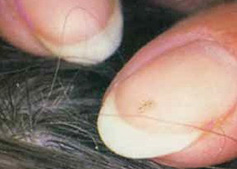
Infestation with head lice can be easily mistaken for dandruff, scabs, or hair spray droplets. The louse lays its eggs on the hair shaft and hatches in six to nine days. The infestation is spread through direct contact, such as head-to-head play, and by sharing personal items. To prevent infection, consult your health care provider if you suspect you have head lice.
A louse infestation is caused by an infestation of the tiny parasites, called louse, that live in the hair on the body. These parasites are transmitted through close person-to-person contact. Head lice are small, wingless insects with long claws and 6 hooklets on their mouth parts. The lice feed for 35-45 minutes and leave the host itchy. Once infected, treatment usually involves washing the hair, scrubbing the affected area, and decontaminating clothing and bedding. Some people may also have to take antiparasitic drugs by mouth.
Despite the widespread myths, head lice can be easily diagnosed. Typically, the infestation is based on the presence of nits in clothing and bedding. The head louse is also called pubic lice, and they usually affect the pubic area and coarse body hair. Lice can be acquired by people who practice proper hygiene. While head lice are most common among homeless individuals, even people who keep their hair in good condition can develop this condition.
An adult female head louse lays her eggs on a hair shaft, usually near the scalp. One body louse lays up to 10 eggs per day. Unlike head lice, these eggs are most often laid at night. Usually, female lice lay their eggs on their heads. The eggs are small, light in color, and visible after infection, but in rare cases, you won’t have any symptoms at all.
The first stage of invasion is the presence of nits. This is an immature form of lice. An adult louse lives for three to four weeks. The female lays six to ten eggs a day. They cannot fly or jump, and they are not infectious. Lice can infect anyone, even if personal hygiene is followed. These infections can be easily treated with the professional treatments described at vietlifemedical.com.

Typically, a head louse lives for about 28 days. The immature stage develops after 6-9 days. The adult stage is followed by an egg that looks like a small mouse. To grow into adulthood, lice need to be within 4-6mm of the scalp. An adult head louse lays up to ten eggs a day. These eggs take 12 to 14 days to reach adults.
The life cycle of a head louse lasts 28 days. During this time, the head louse develops in three stages. Adult female lice lay eggs that stick to the hair shaft. They prefer to lay their eggs close to the scalp so that the eggs cannot survive too far. The nymph stage is similar to the adult, but the female’s head lays eggs at night. Symptoms of head lice infestation are usually very painful.
Before applying the treatment, a person with head lice should clean all objects that have come into contact with the scalp. These items can be washed or boiled, and clothes should be stored in a plastic bag for several weeks. To prevent the spread of lice, it is important to clean carpets and all furniture in the home. Fumigation is not necessary, but it will only exacerbate the problem. Proper home hygiene will prevent lice infestation and help you maintain good hygiene.
The life cycle of a head louse begins as a nit that sticks to the base of the hair shaft. This nit is usually found behind the ears and on the back of the head. Hatching takes five to ten days, and the nymphs begin to feed immediately. It takes seven to ten days for a head louse to fully develop and infect a human body.